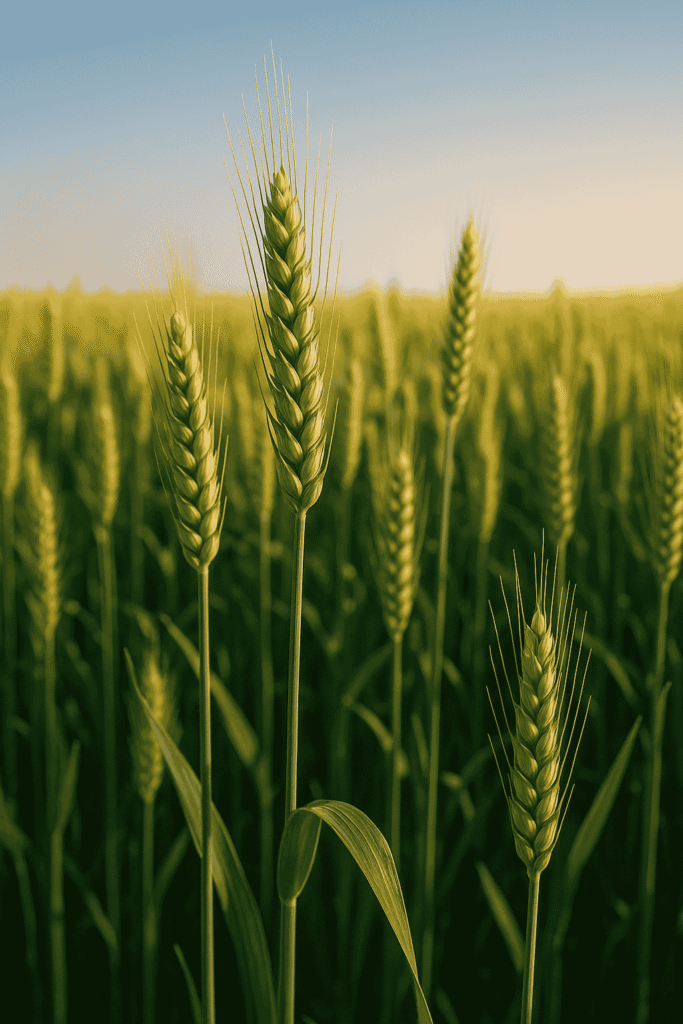Wheat in Pakistan: Agronomy, Diseases, and Value Chain Overview
🌾 Introduction: ROle of Wheat in Pakistan’s Food Security
Wheat (Triticum aestivum) is the most important staple food crop in Pakistan, forming the backbone of national food security. Consumed daily in nearly every household, wheat contributes over 60% of caloric Fintake for the population.
As of 2024, wheat is cultivated over 21.5 million acres, producing around 850 million maunds annually (MNFSR 2024), making Pakistan the 8th largest wheat producer in the world. Despite large-scale production, yields remain below global averages, indicating room for agronomic and post-harvest improvements.
🌱 Wheat Agronomy in Pakistan
1. Agro-Climatic Zones
Pakistan’s agro-ecological diversity allows wheat cultivation across the country:
| Zone | Area | Provinces |
| Irrigated Plains | Punjab, Sindh | Wheat-Rice and Wheat-Cotton zones |
| Barani/Rainfed | Potohar, KPK | Lower yields, OPVs common |
| Arid & Semi-Arid | Balochistan, Thar | Low input zones |
| Highland | Gilgit-Baltistan, AJK | Small-scale, late maturing types |
2. Soil & Climate Requirements
- Optimal Soil pH: 6.0–7.5
- Soil Type: Clay loam to sandy loam
- Temperature: 20–25°C at sowing, cooler during grain filling
- Water Requirement: 16–18 inches of irrigation/rainfall
📅 Sowing Calendar and Season
| Zone | Sowing Period | Harvesting Period |
| Punjab (Irrigated) | November | April – May |
| KPK / Rainfed | Mid-October to early November | May |
| Sindh | Late October | March – April |
| Balochistan | November – December | May – June |
🌾 Popular Varieties Wheat in Pakistan
| Type | Varieties | Features |
| Irrigated (High-yielding) | Punjab-2011, Galaxy-2013, Akbar-2019 | Rust-resistant, >40 maunds/acre |
| Rainfed | NARC-2009, Barani-83 | Drought-tolerant, for Potohar |
| Disease-resistant | Pakistan-2013, Anaj-17 | Leaf and yellow rust resistance |
| Early Maturing | Sarsabz, Sindh-81 | Suitable for Sindh & late sowing |
🦠 Major Diseases of Wheat in Pakistan and Control
| Disease | Pathogen | Symptoms |
| Yellow Rust | Puccinia striiformis | Yellow stripes on leaves |
| Leaf Rust | Puccinia triticina | Reddish-orange pustules |
| Stem Rust | Puccinia graminis | Black streaks on stem |
| Loose Smut | Ustilago tritici | Black powdery heads instead of grains |
Integrated Disease Management
- Use of resistant varieties
- Seed treatment with fungicides like Carboxin + Thiram
- Crop rotation and residue management
- Avoid late sowing to minimize rust impact
🌿 Fertilizer and Irrigation Practices
| Input | Recommended Dose per Acre |
| Urea (N) | 100–120 kg |
| DAP (P) | 45–50 kg |
| SOP/MOP (K) | 25–30 kg |
Irrigation Schedule:
- First irrigation: 20–25 days after sowing
- Second: Tillering stage
- Third: Booting stage
- Fourth: Milk stage
- Fifth (optional): Dough stage
Efficient irrigation methods like laser leveling and raised-bed planting are now encouraged.
🐛 Pests Affecting Wheat and Their Management
| Pest | Symptoms | Management |
| Aphids | Sap sucking, curling leaves | Neem extract, Imidacloprid spray |
| Armyworm | Cut seedlings at base | Manual removal, chlorpyrifos |
| Rodents | Grain damage | Zinc phosphide baiting, traps |
🧺 Harvesting, Yields, and Post-Harvest Losses
- Harvest Time: ~140–150 days after sowing
- Average Yield:
- Punjab (irrigated): 35–40 maunds/acre
- KPK/Barani: 15–25 maunds/acre
Production Statistics Wheat in Pakistan (FAO – Food and Agriculture Organization of the UN)
Post-Harvest Losses:
Estimates suggest 10–15% losses due to improper threshing, storage, and transport.
Preventive Measures:
- Use of mechanical threshers
- Gunny bags, ventilated godowns
- On-farm drying before storage
🏭 Value-Added Chain Wheat in Pakistan
Primary Uses
- Flour mills: Chakki and roller flour
- Bran: Livestock feed
- Bakery & processed foods: Pasta, biscuits, bread
- Industrial use: Gluten, starch extraction
- Export potential: Afghanistan, Gulf (limited)
Key Stakeholders
| Stakeholder | Function |
| Farmers | Wheat producers |
| Government | Price control, seed distribution |
| Seed Companies | PARC, AARI, private firms (e.g., Guard, Pioneer) |
| Traders | Middlemen, market access |
| Flour Mills | Process ~75% of wheat (e.g., Ittefaq, Sunny) |
| Consumers | Domestic and industrial use |
| Exporters | Handle surplus and quality wheat |
| Research Bodies | PARC, AARI, NIAB (variety development) |
🏛 Government Policies and Research Support
- Minimum Support Price (MSP): PKR 3900/40kg (2024-25)
- Wheat Procurement Programs via PASSCO and provincial food departments
- Certified seed production and distribution
- Rust monitoring and early warning systems (with FAO support)
❗ Challenges in the Wheat Sector
- Yield gap compared to world average (Pakistan avg. ~1.8 tons/acre vs. world ~2.8 tons/acre)
- Low certified seed adoption (30–35%)
- Climate change risks (heat stress, drought)
- Water scarcity in canal-fed regions
- Price volatility impacting small farmers
✅ Opportunities for Improvement
- Promotion of high-yielding and climate-resilient varieties
- Mechanization for sowing, harvesting, and storage
- Digitized crop advisory via mobile apps
- Stronger public-private collaboration
- Encouragement of value-added exports (e.g., wheat gluten)
🧠 Conclusion
Wheat in Pakistan is more than just a crop — it is the foundation of national food security and rural livelihood. Improving yields, disease management, and post-harvest practices, while strengthening the value chain and policy support, can ensure sustainability in the face of rising population and climate change. Through innovation, training, and targeted investments, wheat can continue to play a key role in Pakistan’s agricultural and economic resilience.
